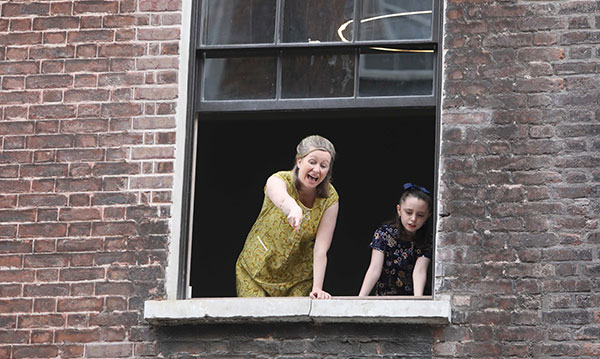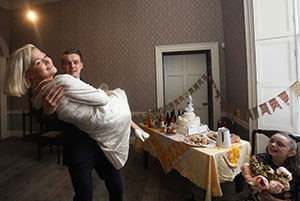Hentown
Published in 20th Century Social Perspectives, Issue 6 (November/December 2017), Reviews, Volume 25ANU Productions
Tenement Museum, 14 Henrietta Street, Dublin 1
By John Gibney

Above: Depending on the luck of the draw for the audience, Hentown starts either out on the street or inside the house.
Hentown is the latest in ANU Productions’ongoing series of location-specific dramas that endeavour to explore murky and uncomfortable aspects of modern Irish history and, more recently, aspects of the ‘Decade of Centenaries’.Hentown moves away from the period 1913–23 but returns ANU to the site of one of its most successful and well-known productions: the ‘Dublin Tenement Experience’, presented in 14 Henrietta Street for the centenary of the 1913 Lockout in 2013. ANU has come a long way since then, and so has 14 Henrietta Street. The building was earmarked to become one of the ‘permanent reminders’ established during the 2016 centenary, in the form of a dedicated (and overdue) tenement museum. Despite a brief wobble when it was suggested that it open as a ‘townhouse’ museum (presumably deemed in some quarters to be a more respectable usage), 14 Henrietta Streethas undergone a remarkable transformation into a new venue with which to explore the history of Dublin in ways that many may find surprising.
‘Tenement’ conjures up a particular type of dwelling: the shabby and decayed townhouses of the ‘ascendancy’ that morphed into Victorian slums. As Dublin was remodelled from the second half of the seventeenth century onwards, much of the inner-city streetscape that survives took recognisable shape, and by the early eighteenth century a number of major aristocratic, residential, districts had emerged. Henrietta Street was the central focus of one of them. It lay at the heart of the sprawling estates of the Gardiner family and was supposedly named after one of two Henriettas (either the duchess of Grafton or the duchess of Bolton). Of fifteen houses originally built on the street thirteen remain, and no. 14 was one of the last built. Having been developed in the 1740s by Luke Gardiner, it was first occupied by Viscount Molesworth but, like so many houses originally used or owned by the aristocracy, it was later occupied by members of the professional classes after the Act of Union deprived many of the aristocracy of their principal reason for being in Dublin. In the 1850s it was occupied by the Encumbered Estates Court (the Victorian equivalent of NAMA) and later by troops from the nearby Linenhall Barracks. Ironically, the Encumbered Estates Court sold off much of the Gardiner estate piecemeal, which precipitated its decline into tenements; by 1873 no. 14 had become the first building on Henrietta Street to be officially classed as a tenement.
The history of the building encapsulates the story of how the aristocratic residences of the eighteenth century gave way to the tenements of the twentieth. No. 14 Henrietta Street even features as a case-study in the new Atlas of the Irish Revolution (reviewed on pp 58–9), and its use by ANU in 2013 reflected the common and understandable assumption that the tenements are inextricably linked to the 1913 Lockout. What is surprisingly less well known, despite the fact that it remains within living memory, is that the tenements survived long into the twentieth century, as attempts to alleviate Dublin’s slum problems were stymied in the absence of both political will and the necessary resources. The new tenement museum will adopt a wide focus, and Hentown is set against the backdrop of the collapse of a tenement house on Bolton Street (around the corner) in 1963.

Above: A young couple celebrate their wedding, one of the interweaving stories told in Hentown.
Depending on the luck of the draw for the audience, it starts either out on the street or inside the house. It takes the form of a series of interlocking vignettes running in parallel, in what areessentially two narratives running side by side and largely sealed off from one another: one resident tries to smuggle a canary past his sister, a young couple celebrate their wedding, a father mourns a stillborn child and the narrative loops back to the failure of the marriage celebrated earlier. The acting is of a very high standard, and this is better described as an experience thanas a performance. This makes it difficult to fully disentangle the drama—and no single review will capture every facet of the production—from the history of the house itself and its future role as a museum.

Above: The physical setting of 14 Henrietta Street gives Hentown an atmospheric immediacy, one that would be impossible to replicate in a standard theatrical setting.
But perhaps this is the point. Hentown brings the history of Dublin’s tenements uncomfortably close to the present, by ending on the eve of their depopulation in the 1960s. It is worth taking a cue from Erika Hanna’s recent observation in the Dublin Review of Books that, despite the best efforts of the city fathers, tourist authorities and developers to fix the image of Dublin as ‘medieval’ or ‘Georgian’, it is, in its totality, a city that dates from the middle of the twentieth century, and the bulk of the city takes the form of the vast expanse of suburbs constructed after independence. The 1930s saw the creation of Crumlin; the 1960s saw the creation of Ballymun. And the population who lived in these new areas were often the relocated inhabitants of the old city, as traditionally fixed between the canals. Dublin’s starting fifteen in the 2017 All-Ireland football final were drawn from GAA clubs throughout the suburbs rather than the inner city. The inhabitants of one became the inhabitants of the other, and this ensures that the reality of tenement life in Dublin remains linked to the suburban realities of today. It is an evolution—not always welcome—that runs through Hentown, and which is fundamental to the story of the city that will be mediated through the Tenement Museum.
Hentown was an excellent production—powerful, humorous, thought-provoking and invariably surprising—and while its run will have ended by the time this review is published, the story that it sought to encapsulate willbe told in this vital new addition to Dublin’s cultural landscape (and the tenement museum will be reviewed in its own right in a future edition of History Ireland). Dublin has long had need of a ‘people’s history’; this new museum will tell a great part of that collective story, and may also provide a venue to facilitate how it will continue to be told.
John Gibney is the author of Dublin: a new illustrated history (Collins Press, 2017).
















